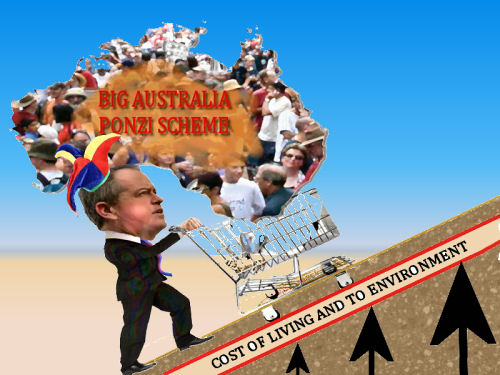 "Strong population growth is boosting aggregate demand and therefore the growth rate of the economy. But measures of per capita outcomes are more sobering and suggest that not enough emphasis is being placed on them in the policy debate. A brief look at income per capita, dwelling prices to income, infrastructure spend per capita and traffic congestion points to the need for a comprehensive and open discussion around the policy direction Australia is taking. ... The pressures of very high immigration are contributing to social, environmental and economic stress in Australia. There appears to be a tri-party (coalition, Labor and Greens) agreement to keep this off the agenda, despite high levels of public concern."
"Strong population growth is boosting aggregate demand and therefore the growth rate of the economy. But measures of per capita outcomes are more sobering and suggest that not enough emphasis is being placed on them in the policy debate. A brief look at income per capita, dwelling prices to income, infrastructure spend per capita and traffic congestion points to the need for a comprehensive and open discussion around the policy direction Australia is taking. ... The pressures of very high immigration are contributing to social, environmental and economic stress in Australia. There appears to be a tri-party (coalition, Labor and Greens) agreement to keep this off the agenda, despite high levels of public concern."

[The following is based on a letter sent to Bill Shorten, Chris Bowen and Senator Penny Wong]
Why is Labor still pushing the ‘Big Australia’ barrow – as evidenced by recent speeches by Chris Bowen at the Crescent Institute in September 2016 and Senator Penny Wong at the National Press Club on 8 November?
For most of this century, Australia has had the second highest population growth rate in the OECD and 2.5 times the OECD average. Since 2003, our population has grown by a massive 22 percent. Official forecasts show Sydney with a population of 6.4 million in 2036 (growth of 87,000 per year), and Melbourne with 8 million in 2036 (growth of 97,000 per year). (for data source, see Leith van Onselen, Who will rise up to become Australia’s Trump? (paywall))
This overheated population growth is putting massive pressures on infrastructure and housing affordability. The continuing urban sprawl is trashing wildlife habitat and scarce agricultural land.
Permanent immigration, as well as an unprecedented amount of 457 and student visas, is having a detrimental effect on wage rates, particularly for lower skilled and lower income workers. Why is Labor endorsing this?
The real national disposable income per capita of Australians is in decline, thanks in large part to this population growth. May I draw your attention to the conclusion in the recent research note by Gareth Aird of the Commonwealth Bank:
Strong population growth is boosting aggregate demand and therefore the growth rate of the economy. But measures of per capita outcomes are more sobering and suggest that not enough emphasis is being placed on them in the policy debate. A brief look at income per capita, dwelling prices to income, infrastructure spend per capita and traffic congestion points to the need for a comprehensive and open discussion around the policy direction Australia is taking.
May I also draw your attention to the conclusion of the recent research note by Leith van Onselen of Macrobusiness:
In short, the broad macroeconomic data – both domestic and international – does not support the assertion that Australia needs to run a high immigration program in order to drive the economy and increase living standards. In fact, given the significant qualitative costs – for example, the degradation of the environment, the depreciation of natural resources and decline in individuals’ quality of life – there is significant cause to dial Australia’s immigration program right back.
Recently Senator Wong cited the recent Productivity Commission report on Migrant Intake Into Australia, and its modelling which showed a $7000 increment to per capita GDP in 2060, when comparing a business-as-usual immigration scenario to a zero net overseas migration (NOM) scenario. In actuality, the Commission bends over backwards to explain in its report that the $7000 figure is not a net benefit. One must also look at the costs of immigration and assess the overall net benefits for the community as a whole. For example the Commission says:
GDP per person is a weak measure of the overall wellbeing of the Australian community and does not capture how gains would be distributed among the community. Whether a particular rate of immigration will deliver an overall benefit to the existing Australian community will crucially depend on the distribution of the gains and the interrelated social and environmental impacts.
I am not sure whether Senator Wong simply misunderstands the Commission’s findings, or whether this is wilful misuse of data for a particular agenda. May I suggest that Senator Wong carefully read pages 15 to 17 of the Overview, to appreciate the nuance of the Commission’s findings.
The pressures of very high immigration are contributing to social, environmental and economic stress in Australia. There appears to be a tri-party (coalition, Labor and Greens) agreement to keep this off the agenda, despite high levels of public concern. According the Productivity Commission report:
Despite majority support for immigration, almost two thirds of survey respondents expressed strong preferences for keeping the population below 30 million over the next 40 years, which with current rates of immigration could be reached by around 2030. While the reasons given by survey respondents for preferring a lower population size differ between sub-groups, congestion and environmental impacts featured for all sub-groups. (p. 362)
Actually, the Commission may be correct that there is majority support for immigration in principle, but there is definitely not majority public support for the very high levels of immigration we have seen this century. A recent survey for SBS found that 59% of Australians surveyed believed that “the level of immigration into Australia over the last ten years has been too high”. This is backed up by a recent (5 October 2016) Essential poll that found that 50% think that the level of immigration into Australia over the last ten years has been too high, 28% think it has been about right and 12% think it has been too low. And for Labor voters, it was 43% think that the level of immigration into Australia over the last ten years has been too high, 30% think it has been about right and 16% think it has been too low.
As the Productivity Commission has acknowledged, Australia’s immigration policy is our de facto population policy. Recent events elsewhere (eg Brexit, Trump) suggest there is rising public concern about the pressures caused by growing population and high levels of immigration. If the major parties in Australia maintain their consensus for a Big Australia, contrary to the clear wishes of the majority, where will voters go? One Nation?
I ask again, why is Labor pushing for a Big Australia?
This article was first published on Peter Cook's personal blog at http://www.peakdecisions.org/2016/11/labor-pushing-big-australia

Comments
VivKay (not verified)
Fri, 2016-11-18 08:36
Permalink
Voters will move onto "anti-immigration" parties
Dennis K
Sat, 2016-11-26 12:09
Permalink
Economics wasn't a priority in great civilisation
David Hughes (not verified)
Fri, 2016-11-25 22:39
Permalink
Do backpackers pay any tax?
quark
Sun, 2016-11-27 15:43
Permalink
Overseas investment in urban sprawl
According to this article in The Age, Land to the north of Melbourne is being sold off in Singapore for investment properties with a guaranteed 5% p.a. income stream.http://www.theage.com.au/victoria/public-land-spruiked-in-singapore-20161124-gsx10f.html
Add comment